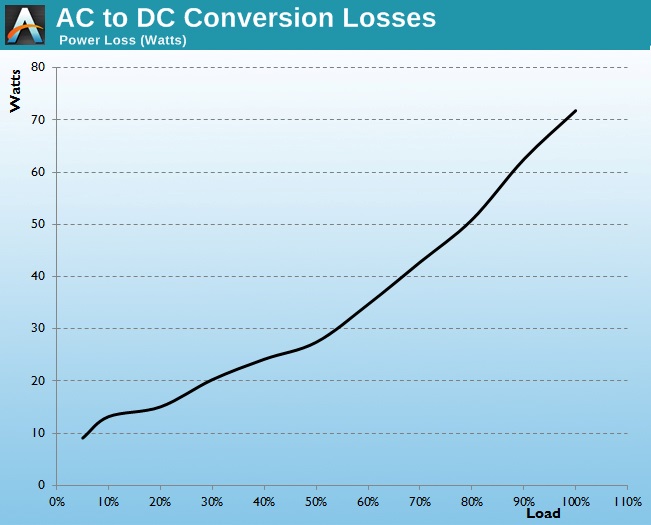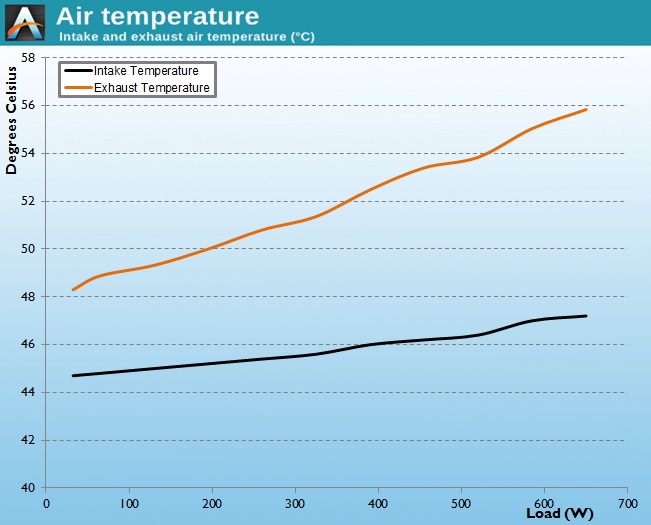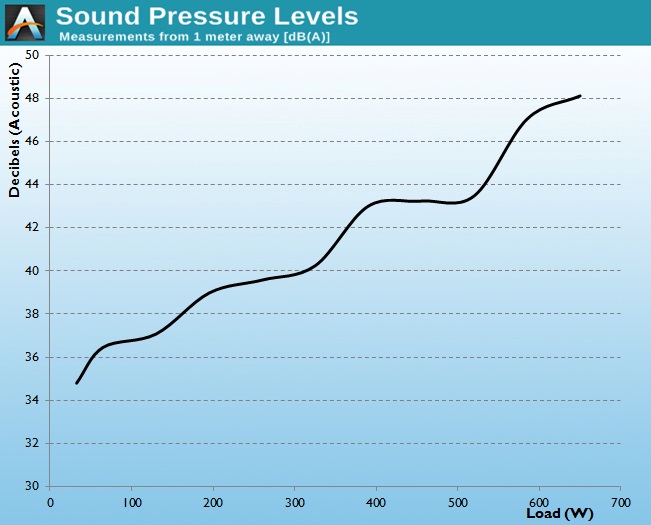Be Quiet! Dark Power Pro 10 650W & 850W PSU Review
by E. Fylladitakis on February 2, 2015 11:40 AM ESTDark Power Pro 10 650W Hot Test Results
From the tables below, it can be seen that the output power quality of the be quiet! Dark Power Pro 10 650W PSU is average. FSP designs do not usually excel when it comes to power quality and this is no exception, with the voltage ripple on the 12V line going up to 68mV when the unit is fully loaded. If the PSU is heavily cross-loaded, the ripple increases even further. These figures are well within the 120mV limit of the ATX design guide but certainly not impressive for a flagship series product. The voltage regulation on all of the lines is about 2.5%, a good but unremarkable figure.
| Main Output | ||||||||
| Load (Watts) | 132.35 W | 328.7 W | 486.47 W | 645.37 W | ||||
| Load (Percent) | 20.36% | 50.57% | 74.84% | 99.29% | ||||
| Line | Amperes | Volts | Amperes | Volts | Amperes | Volts | Amperes | Volts |
| 3.3 V | 3.8 | 3.37 | 9.5 | 3.34 | 14.25 | 3.3 | 18.99 | 3.28 |
| 5 V | 3.8 | 5.08 | 9.5 | 5.05 | 14.25 | 4.97 | 18.99 | 4.95 |
| 12 V | 8.21 | 12.21 | 20.51 | 12.14 | 30.77 | 11.98 | 41.03 | 11.92 |
| Line | Regulation (20% to 100% load) |
Voltage Ripple (mV) | |||||
| 20% Load | 50% Load | 75% Load | 100% Load | CL1 12V |
CL2 3.3V + 5V |
||
| 3.3V | 2.6% | 12 | 18 | 20 | 26 | 16 | 28 |
| 5V | 2.6% | 16 | 20 | 24 | 30 | 16 | 32 |
| 12V | 2.4% | 22 | 36 | 50 | 68 | 74 | 30 |
High ambient temperatures have an impact on the energy conversion efficiency of the be quiet! Dark Power Pro 10 650W PSU, but not overly so. The average nominal load (20-100%) efficiency is reduced down to 90.1%, a justifiable drop of 0.8% for an ambient temperature increase of about 22°C. Again, the efficiency peaks at 50% load, but at 91.4% this time, presenting a 0.9% drop.
Due to the higher temperatures, this time the cooling system of the Dark Power Pro 10 650W PSU behaves more aggressively, speeding up the fan even at lower loads. The PSU does maintain reasonably comfortable acoustic levels with a load up to 350 Watts, beyond which point the fan has to increase its speed in order to counter the increasing energy losses. At heavy loads and with an ambient temperature of over 45°C, the Dark Power Pro 10 650W unit is clearly audible but not overly so, while the cooling system manages to maintain good internal temperatures.















25 Comments
View All Comments
maeda_toshiie - Monday, February 2, 2015 - link
"CapXon is a reputable company and their polymer capacitors are among the best worldwide"????? You do know CapXon's reputation and its position in the cap quality rankings...?!
Tator Tot - Monday, February 2, 2015 - link
There's a large difference between Polymer Capacitors & Electrolytic capacitors; CapXon's reputation comes from the quality of their electrolytic capacitors, not their polymers. Polymer capacitors, in general, are pretty hard to mess up though. You'd really have to try to make bad poly's.E.Fyll - Monday, February 2, 2015 - link
Perfectly so. CapXon is one of the ten largest and most reputable companies worldwide. They do have a mediocre reputation, half due to a couple of bad series and half because their products were used in horrible designs, but claiming that they are bad when therea re three dozen worse companies, or trying to suggest that only Japanese companies make good capacitors (in Taiwan), is...not useful.dishayu - Tuesday, February 3, 2015 - link
I can't objectively comment on the quality CapXon capacitors, but i've personally had a poor experience with them in the past and if you google for CapXon you see nothing but criticism and poor reviews. They are very commonly called crapxon on the internet. I don't see how any of that equates to being reputable.4745454b - Tuesday, February 3, 2015 - link
I sort of learned this lesson with my Antec Smart Power 450W. (If you know caps, you know what was in that.) Once I figured out there was a possible problem with my PSU I did what I could to prevent it. I blew the dust out every three months, and kept the tower as a whole as cool as possible. Then I after a year or so I bought a better PSU, the EA500. I don't remember the system it powered back then, probably my E6600 and 7750. My roommate needed a PSU after I upgraded it and I stuck that in there telling her to be gentle with it. Her system was an old P4 with a 9800 I think. (ATI 9800, not Nvidia 9800.) She didn't listen and stuck her case in that sweat box some/most desks come with because "that's where the computer goes right?" Needless to say the PSU didn't last long.The point I'm trying to make is even bad caps can do their job if you are nice to them. And just because a cap doesn't come from X region doesn't mean it's bad.
shadowjk - Friday, February 6, 2015 - link
I'm not familiar with the reputation of individual manufacturers, but even assuming that every capacitor make and model meet their manufacturer's specifications, you can still end up with capacitor death.Capacitors have a defined expected lifetime, at a specific temperature, voltage, and ripple current. The "headline" ratings usually put you in the ballpark of a few thousand hours life expectancy, which is only slightly better than how long a classic light bulb lasts before burning out.
In a poor design, the voltage and temperature limits are usually met by the design, but ripple current spec is exceeded (if we presume the designer aimed for half decent usable life). Temp and V can be checked by average Joe user, ripple current is trickier.
I wonder if the "reputable" jp manufacturers have strings attached to sales, to make sure nobody blows up their capacitors...
extide - Monday, February 2, 2015 - link
Wow, that scope is pretty ancient and crappy! I mean, at least go for the Rigol DS1054Z -- twice the sample rate (max) and tons of features for a really great price.E.Fyll - Monday, February 2, 2015 - link
The scope is old but it is reliable and excels the required specifications....and I want a much better oscilloscope too, but things do tend to be more complicated when you actually have to pay for it.
jordanclock - Monday, February 2, 2015 - link
As someone that isn't particularly well versed in oscilloscopes, would a "better" model make a difference in the results of an Anandtech review? I know you all strive for the highest quality in your reviews, but is this an example of little return on investment?E.Fyll - Monday, February 2, 2015 - link
Not more accurate results on the current tests, but a better oscilloscope would allow for more tests. It will happen eventually but, with a price tag of nearly $9000, it will take a while.